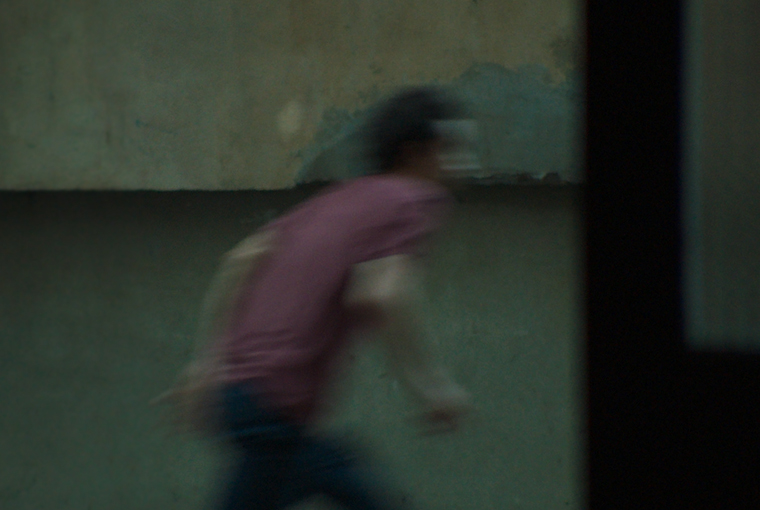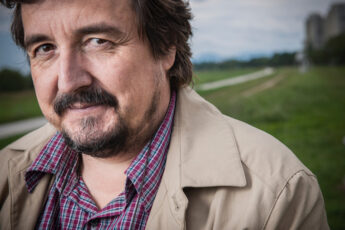To See Is to Understand
Juraj Lerotić’s Safe Place (Sigurno mjesto, 2022)
Vol. 132 (February 2023) by Ana Grgić
Keeping your eyes open on yourself and on the world, on the front of the mirror and on the back of the mirror in order to hold off the night.
– Paul Eluard (La Poésie du Passé, 1951)1
How do you represent the un-representable? The unimaginable? Do you turn off all the lights and whisper, turning to darkness, in the hope to communicate what is inconceivable? Ironically, Juraj Lerotić’s debut feature Safe Place is not a safe place at all. Not for its protagonists, and not for its spectators. To enter Safe Place is to confront yourself with a void. With the unexplainable. With the unspeakable. Yet no matter how difficult it gets, you feel compelled to keep looking as Lerotić keeps the camera rolling. He compels us to keep our eyes open, “on the front of the mirror and on the back of the mirror”, like in Paul Eluard’s poem, “in order to hold off the night”. Because, we are deeply aware, right from the beginning, that the night is coming. And yet, we keep watching, and we hope for catharsis. After all, it is also a powerful film about affectionate love, brotherhood, and humanity.
Safe Place had its Greek premiere at the 63rd Thessaloniki International Film Festival, where it was shown as part of the Meet the Neighbors section with the director in attendance for the full-house post-screening Q&A sessions. This feature-length debut premiered earlier in 2022 at the Locarno International Film Festival Cineasti del presente competition, where it garnered three awards, including the prize for best debut feature. It continued to sweep awards and draw critical acclaim as it toured on the film festival circuit, winning both The Heart of Sarajevo Award for best film and the Best Actor award after its regional premiere at the Sarajevo International Film Festival. While finishing the writing of this review, the film had just won a Special Mention at the 2023 Trieste International Film Festival, and continues on a very successful theatrical run in the director’s home country.
Announced by a poetic and foreboding opening quote – “If none of this had happened, I could have told you: Look, this is your building, count to twenty and I’ll come running into the scene” –, the film sets the tone from the beginning, making spectators aware that we are watching a film, that what we see is, indeed, fiction. And this is where it gets tricky. Safe Place actually draws on and plays on the director’s own painful family history, the suicide of his own brother. Over the course of a day, the film chronicles the harrowing psychological journey of the family, following the brother’s attempted suicide, in their search for a safe place. The film starts with Bruno, played by the director Juraj Lerotić himself, running into the scene and heading towards a featureless post-Socialist building, to breaking down a door and discovering that his brother Damir, played by the talented Croatian actor Goran Marković (known internationally for his performance in Dalibor Matanić’s critically acclaimed 2015 The High Sun), has attempted suicide. From this point, the film slowly constructs and unravels the family tragedy, from the capital Zagreb to their seaside hometown, Split, as the brothers are joined by their mother (played by the convincing character actress, Snježana Sinovičić Šiškov) who has learned of the events. The director’s choice to act as his fictional self, may seem indulgent to some, and reminiscent of performances of directors such as Woody Allen or even Nanni Moretti and their nervous and quirky energy, yet Lerotić comes across as authentic and incredibly fragile. Perhaps this choice of a performative iteration, in the fictional universe of a real past event, carries cathartic weight as an act of repetition.
The film’s stylistic choices and narrative approach draw on recognizable characteristics of “slow cinema” (prevalent at festivals and in independent cinema since the 2000s), as well as New Romanian Cinema, as noted by several critics. Broadly speaking, scenes in the representative films of the New Romanian Cinema primarily function as tableaux. There is a predominance of lengthy medium shots with no camera movement, and the dramaturgy tends to focus on everyday situations with restrained dialogues. However, Lerotić’s somewhat unconventional formalistic solutions, which vacillate between gloomy realism/slow-paced rhythm and more dramatic events and acts such as frantic running, fittingly reflect the fragile psychological state of the characters and the incoherence of thoughts. In my view, the film also owes a great deal to the films of Nulgi Bilge Ceylan, in particular, the building of a felt psychological meta-space and the very complex use of sound design, palpable in Ceylan’s Three Monkeys and his Uzak. Safe Place recalls and draws on other artistic traditions, too. It is impossible not to think of the extreme perspective in the famous Renaissance painting, Andrea Mantegna’s Cristo morto (1485), and its subsequent citation in Pier Paolo Pasolini’s powerful finale in Mamma Roma (1962), when Damir is confined again to the hospital bed after he had attempted suicide for the second time at the police station. Like Ettore in Mamma Roma, this image of Damir powerfully evokes and presages the film’s ending.
The mise-en-scene powerfully conveys the disorientation of the family caught in an impossible situation, between the cold bureaucratic machine of state hospitals and the police, incompetent and absent psychologists and doctors, and their desperation to save a loved brother and son. Together with experienced Slovenian cinematographer Marko Brdar,2 who has numerous credits under his belt, Lerotić creates a compelling visual experience, through strong angles and compositions of interiors and exteriors and a drab yet affect-full color palette and tones. Obstructions, doors, shadows and reflections in bleak, mostly rundown hospital interiors, waiting rooms, and offices, reflect the all too familiar cinematic look of the post-Socialist Eastern European rundown spaces, but more importantly, these devices create a feeling of anxiety and confine the characters to their inescapable fate. Some strong stylistic choices make A Safe Place stand out, however, from the conventional post-Socialist Eastern European aesthetics. For instance, the scene in which the two brothers have a conversation about Damir’s death, at the beginning of the film, cleverly breaks our expectations of the fictional element and classical film structure, through a small and yet perceptible change in the mise-en-scene, Damir’s costume and an already lit cigarette which he pulls out from his front shirt pocket. Or take the masterful use of sound, such as the quasi-avantgarde poetic ending, launched by the mother’s piercing shrill at the news of her son’s death. The film cuts to experimental images of frantic camera movements, which appear out of control, in order to settle on a moment from the past, evoked earlier in the film through a color photograph, which Bruno gives to the police when they come searching for Damir after he had escaped from the hospital. It’s summertime, boys are jumping into the sea from a concrete wall, while Damir turns and looks towards us and the film’s author, his brother. We never see the sky, as the framing and composition – be it in the monotonous interiors of the hospitals and police stations, and non-descript apartments, or once on the sunny Adriatic coast – continue to convey a strong sense of imprisonment and confinement, and the impossibility of escape.
This is a film which cuts deeply into one of society’s taboos, the question of suicide and mental health, and our incapacity to deal with their consequences. Safe Place is also a subtle and poignant critique of the Croatian health care system, the police, and systemic bureaucracy, recalling films such as The Death of Mr Lazarescu (dir. Cristi Puiu, 2005),3 and furthermore, in terms of its theme, the more recent Romanian documentary Collective (dir. Alexander Nanau, 2019), which exposed the country’s catastrophic health care system. Through this film, Lerotić takes a hard look at the inhumane and mechanistic bureaucracy of the Croatian health care system, and at its failures.4 Recent protests following the death of an investigative journalist in Split, who died after not being admitted to the hospital,5 continue to point to financial and systemic difficulties of the current system, which is neither able to provide a safe place, nor adequate care for its citizens. Despite the moodiness of the film’s tone, there is also something of a local flavor about A Safe Place, such as allusions and light-hearted humor, exchanged between Bruno and the mother throughout the film: “When I first tried Normabel, I thought they should give the Noble prize to the person who invented it”. Or further in the scene when Damir ironically notes that his arm is cut up just like Terminator’s, which adds a touch of light-heartedness and humanity in an otherwise dire situation. Perhaps Lerotić’s film will not lead directly to significant changes in Croatia’s healthcare system lacking political will, but nonetheless, the film opens up a dialogue about neglected issues in Croatian society, notably mental health and the need for psychologists.
References
- 1.Eluard, Paul. Capital of Pain. English translation by Mary Ann Caws, Patricia Terry and Nancy Kline. Black Widow Press, 2006.
- 2.Polona Petek has described the uniqueness of Marko Brdar’s cinematography as “bruised-looking photography’’ in her discussion of the Slovenian film, Ivan (dir. Janez Burger, 2017). Petek, Polona. “12. Slovenia: A small national cinema in the phase of transnational synergy’’. In: Contemporary Balkan Cinema. Edinburgh University Press, 2020, 208-227; 211.
- 3.Marko Njegic, Slobodna Dalmacija, https://slobodnadalmacija.hr/kultura/film-tv/sigurno-mjesto-bolna-hrvatska-drama-bez-presedana-1235307 [Accessed on 8 March 2023] and Neil Young, Screen Daily https://www.screendaily.com/reviews/safe-place-sarajevo-review/5173408.article [Accessed on 8 March 2023].
- 4.The death of investigative journalist Vladimir Matijanić in Split in August 2022 has prompted a series of protests across the country for better health care, and has led to the Croatian Journalists Association demanding the resignation of Health Minister Vili Beroš. See Vuk Tesija, Balkan Insight, https://balkaninsight.com/2023/02/06/croatian-journalists-demand-investigation-into-colleagues-death/ [Accessed on 8 March 2023].
- 5.The daily newspaper Jutarnji List reports the need for health care reform, due to a high number of deaths per 100,000 inhabitants, and difficulty in reaching the hospital in an emergency. Goranka Jureško, Jutarnji List, https://www.jutarnji.hr/vijesti/hrvatska/slovenci-imaju-manje-lijecnika-i-manje-bolnica-nego-hrvatska-ali-i-bitno-manju-smrtnost-gradana-15263411 [Accessed on 8 March 2023].




Leave a Comment